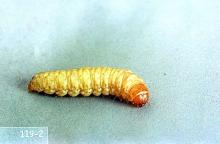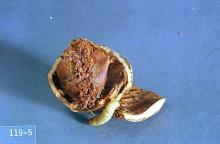Cydia latiferreana
Pest description and crop damage Adult moths have a wingspread of about 0.5 inch. Moths are gray to reddish with golden bands across each forewing. When mature, larvae are whitish with a translucent, amber-colored head, 0.5 inch long. Larvae feed within the nut and destroy the kernel.
Biology and life history Filbertworm overwinters as larvae in silken cocoons, which may be found under leaves and leaf litter on the ground, or in cracks and crevices in bark. Some larvae also overwinter 1 to 2 inches beneath the soil surface. Larvae pupate, then the adults emerge beginning in mid-June. Moth emergence continues through October. After emergence, the adults find mates and lay eggs singly near developing nuts. Eggs mature in 8 to 10 days, and the larvae then move about in search of a nut to feed on. They burrow into the nut, feed on the kernel for 2 to 4 weeks, and bore their way back out. Most form cocoons to overwinter, although there may be a partial second generation.
Scouting and thresholds Pheromone traps are used to time sprays for this pest. A degree-day model is available on uspest.org.
Management-chemical control: HOME USE
- acetamiprid-PHI 14 days. No more than 4 applications per season.
- azadirachtin (neem oil) (as a mix with other ingredients)-Some formulations are OMRI-listed for organic use.
- carbaryl-Do not apply to blooming trees or weeds or cover crops in bloom. Deadly to bees. Apply early July and again 3 weeks later.
- gamma cyhalothrin-Highly toxic to bees. Do not apply when bees are actively foraging; wait until after trees have flowered.
- kaolin clay-Acts as repellent. Apply prior to egg laying (815 DD), maintain coverage throughout flight period. Good agitation in spray tank is essential. 4-hour reentry. OMRI approved for organic use.
- lambda-cyhalothrin (often as mix with other chemicals)-Highly toxic to bees. Do not apply when bees are actively foraging; wait until after trees have flowered.
- pyrethrins-Highly toxic to bees. Do not apply when bees are actively foraging; wait until after trees have flowered. Some formulations are OMRI-listed for organic use.
- spinosad-Some formulations are OMRI-listed for organic use. Apply at or just prior to egg hatch to target emergent larvae
- zeta-cypermethrin-Highly toxic to bees. Do not apply when bees are actively foraging; wait until after trees have flowered.
Management-chemical control: COMMERCIAL
Pheromone trapping is encouraged for accurate spray timing.
- acetamiprid (Assail 70WP) at 2.3 to 4.1 oz/A (0.10 to 0.18 lb ai/A). PHI 14 days. No more than 4 applications per season.
- alpha-cypermethrin (Fastac CS) at 3.2 to 3.8 fl oz/A (0.021 to 0.025 lb ai/A). PHI 7 days. REI 12 hr. Do not exceed 11.4 fl oz/A per season. Highly toxic to bees, extremely toxic to fish and aquatic invertebrates. Do not apply within 25 feet of aquatic habitats, or within 150 ft if aerial application. Apply as indicated by scouting.
- beta-cyfluthrin (Baythroid XL) at 2.0 to 2.4 fl oz/A or 0.016 to 0.19 lb ai/A. Maximum per 14 day and per season: 0.022 lb ai/A. PHI 14 days.
- beta-cyfluthrin + imidacloprid (Leverage 360) at 2.8 fl oz/A (0.022 lb ai/A). Maximum 2.8 fl oz/A per year. PHI 14 days.
- bifenthrin-
- Brigade WSB at 0.05 to 0.2 lb ai/A. PHI 7 days. REI 12 hr. Do not graze livestock on treated cover crops. Highly toxic to bees and toxic to fish and aquatic invertebrates.
- Fanfare EC at 3.2 to 12.8 fl oz/A (0.05 to 0.20 lb ai/A). PHI 7 days. Do not graze livestock on treated cover crops. Highly toxic to bees and toxic to fish and aquatic invertebrates. WA only.
- carbaryl (Sevin XLR Plus or its equivalent in another formulation) at 0.5 to 1.25 quarts/100 gal water (2 to 5 quarts/A). PHI 14 days. REI 12 hr. May cause rapid increase of aphid populations 3 to 4 weeks after application. Extremely toxic to aquatic invertebrates.
- chlorantraniliprole (Altacor) at 3 to 4.5 oz/A. PHI 10 days. REI 4 hr.
- Chromobacterium subtsugae strain PRAA4 (Grandevo) at 1 to 3 lb/A. OMRI-listed for organic production.
- diflubenzuron (Dimilin 2L) at 16 fl oz/A. Most effective if applied before egg-laying. Extremely toxic to aquatic invertebrates. Do not apply within 25 ft of bodies of water. Do not make more than 4 applications per season. PHI 28 days. REI 12 hr.
- emamectin benzoate (Proclaim) at 3.2 to 4.8 oz/A. PHI 14 days.
- esfenvalerate (Asana XL) at 8 to 10 fl oz/100 gal water (9.6 to 19.2 fl oz/A or 0.05 to 0.1 lb ai/A). PHI 21 days. REI 12 hr. Do not apply more than 0.2 lb ai/A per season. Extremely toxic to fish and aquatic habitat.
- lambda-cyhalothrin (Warrior II) at 2.56 to 5.12 fl oz/A. PHI 14 days. REI 24 hr. Do not exceed 0.16 lb ai/A per season or 0.12 lb ai post bloom.
- methoxyfenozide (Intrepid 2F) at 8 to 16 fl oz/A. PHI 14 days. REI 4 hr. Apply when egg hatch begins. Reapply at 14- to 21-day intervals under high pressure or sustained moth flight. Do not exceed 24 fl oz/A per application or 64 fl oz/A (1 lb ai/A) per season. Do not apply within 25 ft of an aquatic habitat, 150 ft if applied by air.
- methoxyfenozide + spinetoram (Intrepid Edge) at 6 to 12 oz/A. Apply at initiation of egg hatch, if necessary, reapply after 14 to 21 days, but not before 14 days. PHI 7 days. REI 4 hr. No more than 12 fl oz/A/season.
- permethrin-
- Ambush 25W at 12.8 to 25.6 oz/A. PHI 14 days. Do not graze treated orchards. Extremely toxic to fish and aquatic habitat.
- Ambush at 0.2 to 0.4 lb ai/A. PHI 14 days. REI 12 hr. Do not graze treated orchards. Extremely toxic to fish and aquatic habitat.
- Pounce 3.2 EC at 8 to 16 oz/A. PHI 14 days. REI 12 hr. Do not graze treated orchards. Extremely toxic to fish and aquatic habitat.
- pyriproxyfen (Esteem 35 WP) at 4 to 5 oz/A. Do not apply more than twice per season. PHI 21 days. REI 12 hr.
- spinetoram (Delegate WG) at 1.5 to 1.75 oz/100 gal water (4.5 to 7 oz/A). PHI 14 days. Apply no less than one week apart, with a maximum 4 applications per season.
- spinosad (Entrust SC, Success Naturalyte) at 4 to 10 oz/A (0.06 to 0.16 lb ai/A). PHI 1 days. REI 4 hr. Entrust SC OMRI-listed for organic use. REI 4 hr. Do not exceed 29 oz/A (0.45 lb spinosad) per season.




